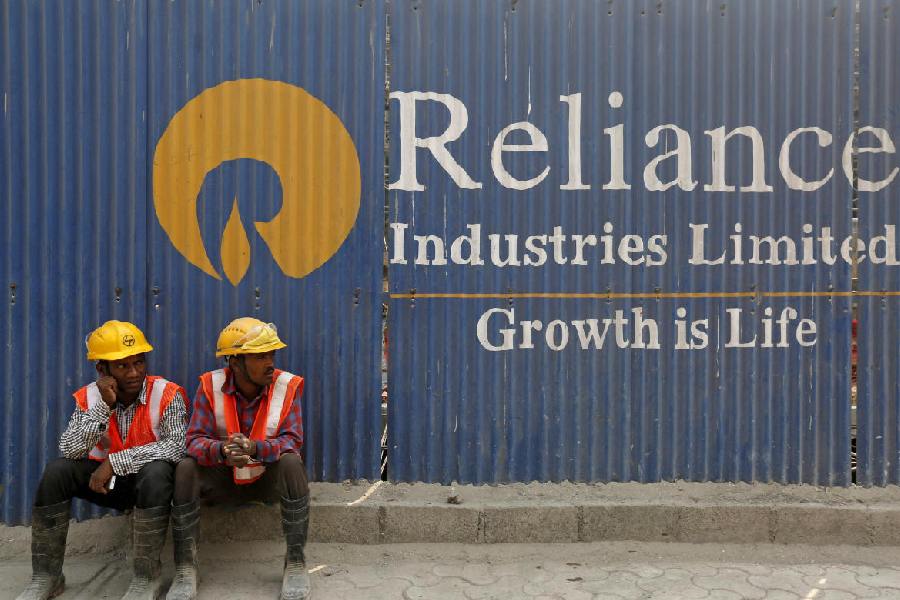Reliance Industries Ltd (RIL) on Friday trailed Street estimates as it reported an 11 per cent fall in net profits for the quarter ended June 30 because of a weak performance of its oil-to-chemicals (O2C) business.
The conglomerate reported a consolidated net profit of Rs 16,011 crore compared with Rs 17,955 crore in the corresponding quarter of the previous year. Analysts were expecting RIL to report net profits in the region of Rs 16,500-17,000 crore.
Its O2C business was a let-down during the quarter as it posted a nearly 18 per cent fall in revenues to Rs 1,33,031 crore compared with Rs 1,61,715 crore in the year-ago period. Similarly, the segment’s EBITDA (earnings before interest, taxes, depreciation and amortisation) fell 23.2 per cent to Rs 15,271 crore from Rs 19,888 crore in the corresponding period of 2022-23.
RIL said that demand was affected by destocking on recessionary fears, high-interest rates and lower price realisation of downstream products.The softness in EBITDA was due to a decline in transportation fuel cracks (refinery margin) and lower downstream chemical margins.
The O2C business accounts for nearly 63 per cent of its total revenues. Due to its disappointing performance, the consolidated revenues of RIL slipped 5.3 per cent to Rs 2,10,831 crore from Rs 2,22,664 crore.
Brokerages such as Morgan Stanley had estimated that RIL will post a 9 per cent rise in revenues and a 14 per cent rise in EBITDA. It’s EBITDA or operating profit stood at Rs 41,982 crore against Rs 39,935 crore in the same period of last year, a rise of 5 per cent.
Observers said that had it not been for Reliance Retail and its digital services business led by Jio, RIL’s performance would have been more disappointing.
Reliance Retail saw consolidated revenues rising 19.47 per cent to Rs 69,962 crore from Rs 58,560 crore in the year-ago period, while the EBITDA from operations showed a strong 25.6 per cent upmove to Rs 4,896 crore (Rs 3,897 crore).
At its board meeting, the directors of RIL declared a dividend of Rs 9 per share.
The quarter saw its outstanding debt rising to Rs 3,18,685 crore from Rs 3,13,966 crore in the January-March period. Cash and cash equivalents rose to Rs 1,92,064 crorefrom Rs 1,88,200 crore in the previous quarter.
Jio show
Reliance Jio Infocomm (RJIL) declared a 12 per cent growth in standalone net profits which came in above analyst estimates. RJIL posted a net profit of Rs 4,863 crore against Rs 4,335 crore in the same period of last year.
Brokerages such as ICICI Securities were expecting Jio to clock a net profit of Rs 4,716 crore. During the quarter, Jio’s average revenue per user or ARPU stood at Rs 180.5 against 178.8 in the preceding three months and 175.7 in the corresponding previous quarter — a rise of 2.8 per cent.
Analysts at Morgan Stanley had estimated its ARPU to come at Rs 180 with 8 million subscriber net additions.
RJIL said that the better ARPU was driven by a better subscriber mix and ramp-up of wireline business. The company added 9.2 million subscribers which took its total customer base to 448.5 million.
“Jio continues to make rapid progress in rolling out its True5G network. Jio is on track to complete pan India 5G rollout before December 2023. The new JioBharat phone is another innovation by Jio combining network and device capabilities,’’ Akash M. Ambani, chairman, RJIL, said while commenting on the results.
The good performance from RJIL saw revenues of Jio Platforms rising 11 per cent to Rs 30,640 crore from Rs 27,527 crore a year ago.











